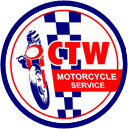Brake Fluid:
HOW OFTEN TO CHANGE: D.O.T. 3 and D.O.T. 4 fluids absorb water, which deteriorates their performance by lowering the fluid’s boiling point substantially. Water can also cause corrosion of brake cylinders or pistons, which can cause functional problems and lead to a gritty deposit in the system. Expert recommendations for replacement intervals range from every six months to every two years. You should also change the fluid when it becomes dark or cloudy, indicating contamination. Change it any time you notice a braking abnormality, such as mushiness when the brakes start to get hot. Change it any time you suspect moisture might be in the system (such as when you find a loose reservoir-cap screw). Change fluid and bleed the system any time you remove a hydraulic component or if air gets in the system-perhaps the fluid was low or the lever was operated while the bike was on its side. You may be tempted to postpone a brake-fluid change. After all, there are many motorcycles riding around with fluid that has never been changed. Most of them have brakes that work okay-until they get hot or corrosion develops. This is such a simple task that avoiding it just isn’t worth the risk. Nothing quite matches the experience of rushing toward an immovable object and having the lever come to the grip with no effect.
Brake Pads::
WHEN TO CHANGE PADS: Replace pads before they approach the minimum thickness specified by the manufacturer or if they get covered with oil, as pads frequently do when your fork seals leak. There is no way to reverse the contamination.
HOW TO BRAKE IN NEW PADS: Use them gently at first until about 75 percent of the pads’ surfaces shows some wear. If you don’t want to take the pads out and look at them, figure that this takes a couple hundred miles. This much wear presents even contact with the disc for the second step, which involves getting the pads hot to cure the resins. During this step, you want to get the pad as hot as you will ever get it, so a fast ride down your favorite switchback-riddled downhill run is just the ticket. If you frequently use your brakes hard-which only happens under racing conditions-and don’t get the pads as hot as you do later, they will fade the first time they reach a higher temperature. Let them cool off (best done by riding for 20 minutes or so without using your brakes) and they are ready for regular service.
